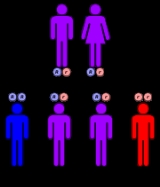
Omenn syndrome
Encyclopedia
Omenn syndrome is an autosomal recessive severe combined immunodeficiency
associated with mutation
s in the recombination activating gene
s (RAG1 and RAG2), affecting circulating levels of both B-cells and T-cells.
(GVHD). This is because the patients have some T cells with limited levels of recombination with the mutant RAG genes. These T cells are abnormal and have a very specific affinity for self antigens found in the thymus and in the periphery. Therefore, these T cells are auto-reactive and cause the GVHD phenotype.
Symptoms include:

ation and cord blood
stem cells.
Severe combined immunodeficiency
Severe combined immunodeficiency , is a genetic disorder in which both "arms" of the adaptive immune system are impaired due to a defect in one of several possible genes. SCID is a severe form of heritable immunodeficiency...
associated with mutation
Mutation
In molecular biology and genetics, mutations are changes in a genomic sequence: the DNA sequence of a cell's genome or the DNA or RNA sequence of a virus. They can be defined as sudden and spontaneous changes in the cell. Mutations are caused by radiation, viruses, transposons and mutagenic...
s in the recombination activating gene
Recombination activating gene
The recombination activating genes encode enzymes that play an important role in the rearrangement and recombination of the genes of immunoglobulin and T cell receptor molecules during the process of VDJ recombination...
s (RAG1 and RAG2), affecting circulating levels of both B-cells and T-cells.
Symptoms
The symptoms are very similar to graft-versus-host diseaseGraft-versus-host disease
Graft-versus-host disease is a common complication after a stem cell transplant or bone marrow transplant from another person . Immune cells in the donated marrow or stem cells recognize the recipient as "foreign". The transplanted immune cells then attack the host's body cells...
(GVHD). This is because the patients have some T cells with limited levels of recombination with the mutant RAG genes. These T cells are abnormal and have a very specific affinity for self antigens found in the thymus and in the periphery. Therefore, these T cells are auto-reactive and cause the GVHD phenotype.
Symptoms include:
- DesquamationDesquamationDesquamation , also called skin peeling, is the shedding of the outermost membrane or layer of a tissue, such as the skin.-Skin:Normal, nonpathologic desquamation of the skin occurs when keratinocytes, after moving apically over about 14 days, are individually shed unnoticeably...
(shedding the outer layers of skin) - Chronic diarrheaDiarrheaDiarrhea , also spelled diarrhoea, is the condition of having three or more loose or liquid bowel movements per day. It is a common cause of death in developing countries and the second most common cause of infant deaths worldwide. The loss of fluids through diarrhea can cause dehydration and...
- ErythrodermaErythrodermaErythroderma is an inflammatory skin disease with erythema and scaling that affects nearly the entire cutaneous surface....
(widespread reddening of the skin) - HepatosplenomegalyHepatosplenomegalyHepatosplenomegaly is the simultaneous enlargement of both the liver and the spleen . Hepatosplenomegaly can occur as the result of acute viral hepatitis or infectious mononucleosis, or it can be the sign of a serious and life threatening lysosomal storage disease...
(simultaneous enlargement of both the liverLiverThe liver is a vital organ present in vertebrates and some other animals. It has a wide range of functions, including detoxification, protein synthesis, and production of biochemicals necessary for digestion...
and the spleenSpleenThe spleen is an organ found in virtually all vertebrate animals with important roles in regard to red blood cells and the immune system. In humans, it is located in the left upper quadrant of the abdomen. It removes old red blood cells and holds a reserve of blood in case of hemorrhagic shock...
) - LeukocytosisLeukocytosisLeukocytosis is a raised white blood cell count above the normal range in the blood. It is frequently a sign of an inflammatory response, most commonly the result of infection, and is observed in certain parasitic infections...
(elevation of the white blood cell count) - LymphadenopathyLymphadenopathyLymphadenopathy is a term meaning "disease of the lymph nodes." It is, however, almost synonymously used with "swollen/enlarged lymph nodes". It could be due to infection, auto-immune disease, or malignancy....
(swelling of one or more lymph nodes) - Persistent bacterial infections
- Elevated serum IgEImmunoglobulin EImmunoglobulin E is a class of antibody that has been found only in mammals. IgE is a monomeric antibody with 4 Ig-like domains...
Genetics

Treatment
Omenn syndrome is sometimes treated with bone marrow transplantBone marrow transplant
Hematopoietic stem cell transplantation is the transplantation of multipotent hematopoietic stem cell or blood, usually derived from bone marrow, peripheral blood stem cells, or umbilical cord blood...
ation and cord blood
Cord blood
Umbilical cord blood is blood that remains in the placenta and in the attached umbilical cord after childbirth. Cord blood is collected because it contains stem cells which can be used to treat hematopoietic and genetic disorders.-Collection:...
stem cells.

